Angiosperm PlantsAngiosperm plants are also known as "flowering plants." Angiosperms are a key classification of plant life, making up the bulk of all plants on the earth. Angiosperm plants produce seeds enclosed in "fruits," which include fruits we eat and plants we might not think of as fruits like wheat, corn, rice, maple seeds, beans, and corns. The flowers constitute a characteristic element of their reproductive structure, called angiosperms. It is sometimes known as "flowering plants"- although even then, we may not always identify their flowers as the gorgeous colourful petaled objects we think of when we hear the term. 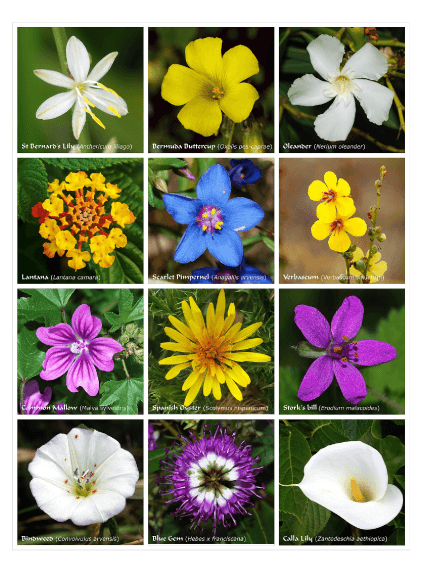
Figure 1: Angiosperm Plants Angiosperms evolved between 250-200 million years ago, and they rapidly added benefit over the earlier dominant plant type- gymnosperms-for two reasons. The use of flowers of angiosperms to reproduce made them more reproductively effective. Whereas gymnosperms mainly depend on wind to attain sexual reproduction by moving pollen-that comprises male reproductive cells for plants-into the ovaries of female plants, to attract insects and another animal, angiosperms utilized sweet-smelling, vividly coloured blooms, and sugary nectar. Angiosperms become more reproductively effective because of this cooperative strategy, in which animals such as bees pollinate flowers in exchange for nectar. Angiosperms also started to enclose their seeds in fruits, which provide more nutrition and protection for their offspring plants, and methods to collaborate with animals. The fruits of many angiosperms, like their flowers, were created to attract to eat them. In many cases, the seed would subsequently travel safety through the digestive tracts of the animals, carrying them far away from the parent plant in the process. Ultimately the seed would discharge in fecal matter, which is often nutrient-rich for plants as an added benefit. The angiosperms were able to spread far and wide as a result of this. As a result, angiosperms now account for more than 80% of all plant species on the planet. Gymnosperms that contain gingko trees, redwoods, palm trees, and pines play a vital role in various ecosystems. However, several gymnosperm species that lived in prehistoric forests have been extinct, replaced by angiosperms. Features of AngiospermsThere are various features of Angiosperms:
Classification of AngiospermsThe angiosperms are classified into two types:
MonocotyledonThe following are the features of monocotyledon:
Dicotyledons
Angiosperms are roughly 250 million years old and make about 80% of all plant life on the planet. They are also a significant food source for both humans and animals. The Life Cycle of an AngiospermKey Points
Key Terms
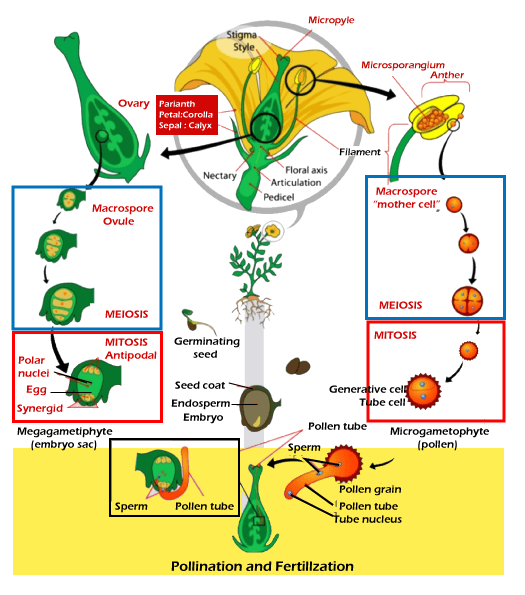
Figure: 2 This diagram shows the lifecycle of an angiosperm. Anthers ad ovaries are structures that shelter the actual gametophytes: the pollen grain and embryo sac. Double fertilization is a process unique to angiosperms. In an angiosperm's life cycle, the adult, or sporophyte, phase is an important phase. For example, gymnosperms, angiosperms are heterosporous. They produce microspores that grow into pollen grains (male gametophytes) and megaspores that form an ovule comprising the female gametophytes. Inside the anther's microsporangia, male microsporocytes split by meiosis, producing haploid microspores which undergo mitosis and produce pollen grains. Each pollen grain compromises two cells; a generative cell which will split into two sperm and pollen tube cells. The ovule, megasporangium, is covered by two layers of integuments, and the over the wall within the ovule, shielded with the carpel's ovary. Within megasporangium, a megasporocyte undergoes meiosis, producing, producing four megaspores; one large and three small. Only the big megaspore survives, ad it forms the embryo sac, female gametophyte. Then, the megaspore splits three times to produce an eight-cell stage. Four of these cells move to each of the embryo sac's poles; two reach the equator and combine to produce a 2n polar nucleus. Thus, antipodals are formed via three cells furthest away from the egg, whereas synergids are formed by the two cells closest to the egg. A central cell in the mature embryo sac consists of an egg cell, two synergids ("helper" cells), three antipodal cells, and two polar nuclei. A pollen tube extends from a pollen grain as it reaches the stigma, grows along with the style, and enters the ovule through the micropyle, a hole in the integuments of the ovule. The two sperm cells are inserted into the embryo sac. After that, there is a twofold fertilization event. A diploid zygote, or future embryo, is formed when sperm and egg combine. Another sperm fuses with the 2n polar nuclei to generate a triploid cell that will grow into endosperm, which is, a food reserve. The zygote develops as an embryo with one root, or small root and one (monocot) or two (dicot) leaf-like organs called cotyledons. The two primary categories of angiosperms, monocots, and eudicots, are distinguished by the number of embryonic leaves they have. Outside the embryo, complex carbohydrates, proteins, or lipids are preserved as seed food stores. The cotyledons act as a conduit carrying broken-down food reserves from the seed's storage place to the growing embryo. The seed contains a toughened integuments making the coat, the endosperm contains food reserves, and the well-protected embryo is found in the core. 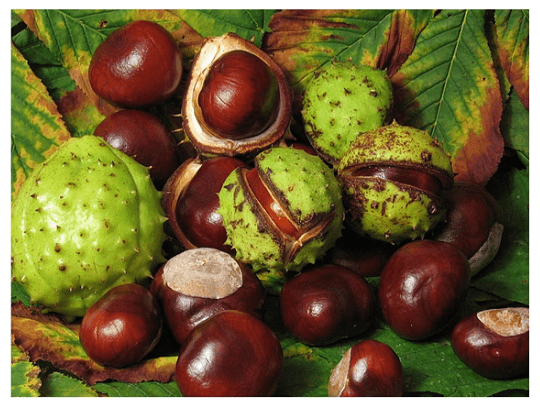
Figure 3: The fruit of the Aesculus or Horse Chestnut tree: these seeds are enclosed a protective outer covering called the seed coat, usually with some stored food. After fertilization and some growth in the angiosperm, the ripened ovule is produced. The formation of the seed completes the process of reproduction in seed plants (started with the development of flowers and pollination), with the embryo developed from the zygote and the seed coat from the integuments of the ovule. Various angiosperm species are hermaphroditic (stamens and pistils are found on the same flower), while others are monoecious (stamens and pistils are found on different blooms but the same plant), and yet others are dioecious (stamens and pistils are found on separate flowers but the same plant) (staminate and pistillate flowers occur on separate plants). Anatomical and environmental barriers promote cross-pollination, which is mediated by a physical agent (water or wind) or an animal-like bird or insect. Cross-pollination boosts a species' genetic diversity. Diversity of AngiospermsBased on the number of cotyledons, angiosperm diversity is categorized into two basic types: monocots and dicots. The Anthophyta is the phylum in which angiosperms are categorized. Modern angiosperms seem to be a monophyletic group, implying that they all originated from a single common ancestor. The structure of the cotyledons and pollen grains, among other things, divides flowering plants into two main groupings. Grass and lilies are monocots, while eudicots and dicots belong to a polyphyletic group. Many species, however, have traits that belong to both groups; as a result, determining whether a plant is a monocot or eudicot is not always straightforward. Basal angiosperms are assumed to have branched off before splitting into eudicots and monocots because they share features with both monocots and eudicots. Many classification schemes categories them individually. The Magnoliidae (such as water lilies, laurels, and magnolia trees) and the Piperaceae such as peppers are two families of angiosperms. Basal AngiospermsPiperales, Nymphaeales, and Magnoliidae are examples of basal angiosperms. These individuals have traits that are found in both monocot and dicot plants. Magnolias, which are tall trees with enormous, fragrant flowers with numerous parts and are considered archaic, represent the Magnoliidae family. The leaves of the laurel tree are aromatic, while the blossoms are little and inconspicuous. Laurales are tiny trees and shrubs that mainly grow in a warmer climate. Familiar plants in this group comprise the avocado tree, cinnamon, bay laurel, and spice brush. The Nymphaeales family lotus, water lilies, and other related plants thrive in freshwater biomes and have leaves that float on the water's surface or float on the ground underwater. Gardeners adore water lilies, which have been adorning ponds and pools for a number of years. Piperales are growing in tropical climates that include shrubs, herbs, and small trees. 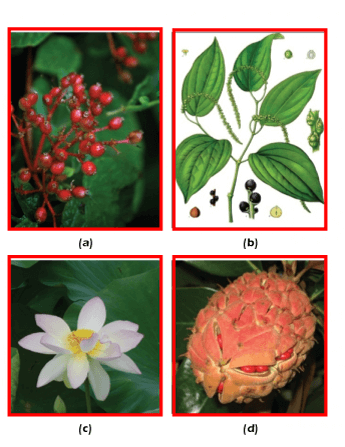
Figure 4: Examples of basal angiosperms: (a) the common spicebush belongs to Laurales, the same family as cinnamon and bay laurel. (b) The fruit of Piper nigrum plant is black pepper, the main product that was traded along spice routes. Notice the small, unobtrusive, clustered flowers. (c) Lotus flowers, Nelumbo nucifera, have been cultivated since ancient times for their ornamental value; the root of the lotus flower is eaten as a vegetable. (d) The red seeds of a magnolia tree, characteristic of the final stage, are just starting to appear. They have small flowers which are non-petaled and are closely grouped in long spikes. Several species provide valuable fragrances or spices, such as the berries of Piper nigrum produce the well-known black peppercorns used to flavour variety of food. Monocots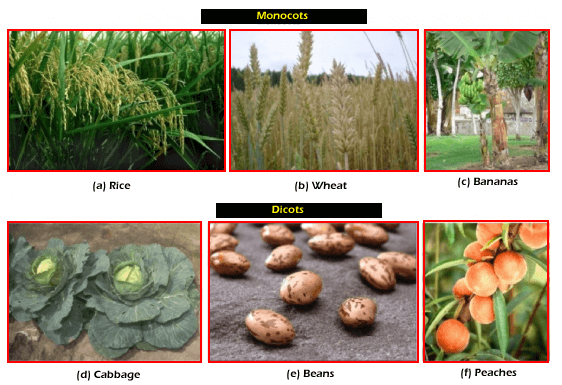
Figure 5: Monocots and Dicots: major crops of the world: The World's major crops are flowering plants. The presence of a single cotyledon in the seeding is the most common way to identify monocot plants. Another anatomical feature shared by monocots contains veins that run parallel to the leaves' length and flower components organized in a three-or-six-fold symmetry. True woods tissue is rare in monocots. The truck in palm trees is made up of vascular and parenchyma tissues generated by the primary and thickening of meristems. The initial angiosperm pollen was monosulcate, having a single grove or pore through the outer layer. This characteristic can still be found in modern monocots. The stem's vascular tissue is not organised in any specific pattern. The root system is mainly adventitious and oddly positioned, with no large tap root. Monocots contain plants like true lilies (that are the origin of their other name: Liliopsida), orchids, palms, and grasses. EudicotsEudicots, or true dicots, are classified based on the existence of two cotyledons in the growing shoot. In leaves, veins create a network, whereas flower parts divided into four, five, or more whorls. In dicots, the vascular tissue is arranged in a ring in the steam, but vascular tissue is dispersed throughout the stem in monocots. Eudicots produce either herbaceous such as grasses or woody tissues. Pollen that is trisulcate or triporate, having three pores or furrows, is produced by various eudicots. Usually, the root system is anchored by one major root formed from the embryonic radicle. Two-thirds of all flowering plants are eudicots. Examples of AngiospermThe following are the examples of angiosperm: 1. FruitsThe life cycle of angiosperms is possibly best illustrated by fruit trees. Fruits trees, like apple, cherry, and orange blossoms, sometimes display flowers before bearing fruit. Fruit trees can exchange genetic material and maintain their population diversified by pollinating these blossoms with bees or other animals. Once flowers have served their purpose of attracting pollinators, they lose their petals, and the carpels start to swell at the base of the flower. These carpels continue to develop until the fruit reaches full size, and they may change colour to attract animals interested in eating it. When birds or ground-dwelling animals consume a tree's fruit, the seed receives a free ride to wherever that animal is heading as well, as free fertilizer in the form of dung will be excreted. 2. GrainsAlthough it may seem unusual to think of grasses as flowering plants, they belong to the family of flowering plants. This is because grasses have evolved beyond their evolutionary origins of luring animal pollinators with large, bright blooms and fruit. Because grasses such as rice and wheat frequently grow in vast numbers extremely close together, they may rely on the wind to pollinate them and spread their seeds via the environment. The kind of wheat, rice, and corn that people eat contain seeds that may be described as "freakishly huge" because we have been choosing to breed our domesticated crops to produce the largest possible seeds for thousands of years. As a result, in the absence of humans, these domesticated plants cannot reproduce because their seeds are too large to be transported by the wind. However, as long as human exist, we will continue to plant a large number of them to feed ourselves! Grass seeds are significantly smaller in the wild and are easily dispersed by the wind. 3. VegetablesHumans have carefully cultivated the veggies that end up on our dinner plates for many generations to make them as big and flavourful as possible. As a result, it may come as a surprise that broccoli, lettuce, and kale are all flowering plants. Lettuce, kale, and broccoli are generally harvested before they flower because flowers are not particularly tasty by various people. Broccoli plants have tight, green buds, which are actually small flower buds. Gardeners and farmers usually permit a few of their green vegetables to flower and develop seeds to sow them for the following year's crop. Green vegetables that are meant to be eaten, on the other hand, are usually piked before their blooms bloom. 4. FlowersWhen it comes to flowers that have been bred to be enormous and bright, our query might be, "where on earth does the fruit come in? The fact is that not all fruits resemble the large, sweet, colourful fruits that are associated with the name. In reality, any protective coating enclosing a seed is referred to as a "fruit," and various plants' "fruits" look like enlarged seed pods. After the petals of some flowers, such as daffodils, lilies, and roses, have fallen off; they produce bloated green seed pods. For example, if we walk through a daffodil orchard after the flower has lost its petals, we may notice that the stems "shake" as they become heavier with the weight of the developing fruit. If we leave the seed pods on the stems for a long time, they will ultimately dry out. However, if we can shake the seed pod and hear the dry seeds rattle inside, it means the seed maturation process is over, and we can harvest the seeds to grow more daffodils next year. The well-known "rosehips," which are occasionally utilized in food or medicine preparations are actually the rose plant's fruit.
Next TopicHow To Translate A Website
|
 For Videos Join Our Youtube Channel: Join Now
For Videos Join Our Youtube Channel: Join Now
Feedback
- Send your Feedback to [email protected]
Help Others, Please Share










